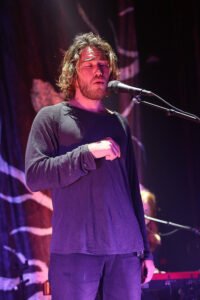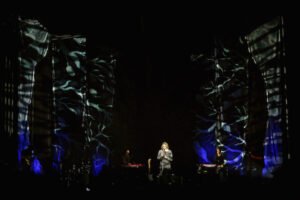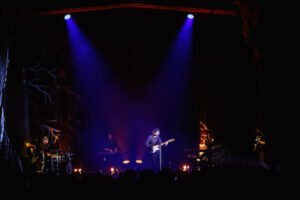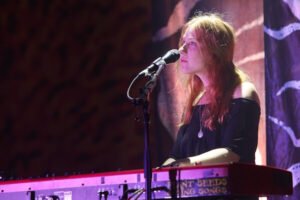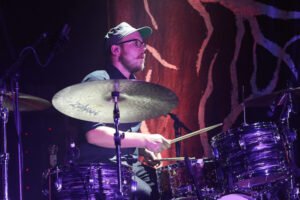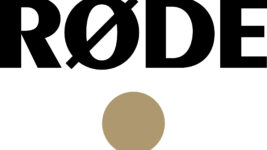News
18 Aug 2016
Matt Corby – Live
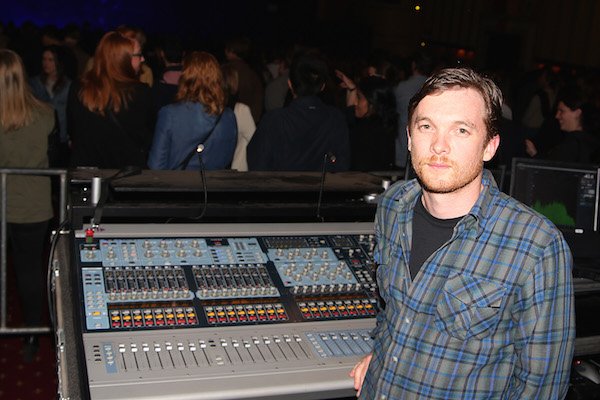
Subscribe to CX E-News
By Cat Strom
 FOH engineer Matt Landers has worked with Australian singer-songwriter Matt Corby since 2012 and is currently touring through Europe with him. Occasionally he has time to mix for other acts such as Ball Park Music, Seekae, Flight Facilities and Sarah Blasko but for the past year he has spent eight months with Matt.
FOH engineer Matt Landers has worked with Australian singer-songwriter Matt Corby since 2012 and is currently touring through Europe with him. Occasionally he has time to mix for other acts such as Ball Park Music, Seekae, Flight Facilities and Sarah Blasko but for the past year he has spent eight months with Matt.
“Matt’s show is definitely the most challenging I’ve mixed but also the most rewarding,” said Matt. “By no means is it a set and forget mix or a snapshot show. It’s all played live, no track or samplers just humans playing instruments on stage. There’s always that element of slight variance or unpredictability plus the feel and vibe on stage is what’s most important to this band and Matt.”
The tour is on the back of Matt’s debut album which came out in March. The album sounds quite different to the live show but both the live and recorded songs have the same energy and deliverance that engages the listener.
“Our on stage sound is actually really quiet which obviously helps me a great deal out the front,” added Matt. “There are no wedges, just a drum sub. The band line up is drums, bass, two keyboardists with BVs and flute, guitarist and Matt on vox and guitar. The bands control of dynamics is pivotal to our show.”
This gig isn’t a high SPL show with clarity and clever use of dynamics preferred, something that is often lost in live music in recent times. For the most part the vocal mic and how Matt is approaching his vocal delivery on the night really dictates the FOH level and is the greatest challenge on any given night.
“We use a condenser on his vocal so that can open up problem areas,” explained Matt. “There’s only so much I can get out of that mic without causing feedback, especially in smaller venues or acoustically challenging venues. Then there’s the loud audience members on a weekend show in Dublin for example… I’ve always got a finger on the main vocal VCA and one on the band VCA mix. There’s tweaks on pretty much every other instrument at certain times and I know all these cues which isn’t really a snapshot kind of situation. My snapshots are effect changes, mutes, panning and that’s pretty much it. So there’s definitely work to be done during the show.”
Matt explains that his aim is to deliver a show that’s an aural journey for the audience and not just how much sub the system can produce. He still wants the show to have impact but he doesn’t want the listeners’ ears or his ears to fatigue after the first three songs.
“So yeah there are definitely moments you’re riding on the seat of your pants but that’s what keeps you agile and attuned to every element of the show,” said Matt.
Matt Corby isn’t a big fan of sound checks with Matt saying that he’s usually giving about 50% vocally as his voice usually hasn’t warmed up by 3pm and he’s saving it for the main event.
“Which is understandable but still……..I’ve used virtual sound check for a while but at the end of the day the band sounds are fine, it’s the open vocal mic’s with the band mix and how that reacts in a room full of people,” he said. “No amount of virtual sound check can imitate 2500 people singing along louder than the PA! Sound check to show mode does change significantly but I know what to expect and not to stress too much. Some sound checks you start to question yourself for sure but those shows sometimes end up being the best ones.”
For the Australian tour Matt used a Venue Profile running off two Midas DL431’s and not using the Avid stage rack.
“We approached our Australian audio supplier about using this combination of Midas pre’s with a Profile after investigating other acts and engineers touring this same rig,” clarified Matt. “I really like mixing on a Profile surface and the Waves integration is far better than the other console manufacturers, in my opinion. Adding Waves to DiGiCo consoles is great but it always feel like you’ve performed an organ transplant, the console often rejecting the unstable foreign object, then never acting the same after this operation ……. plus the myriad of other issues that seem to pop up!”
The mic’s pre’s are controlled from monitor world. Signal is piped to FOH via an AES50 stream into a Klark Technik DN9650 which converts to Madi. A Madi card is installed in the Profile FOH Rack and it’s all clocked via a BigBen. The Profile gain control becomes a trim level which gives Matt 40db to play with. Most inputs he’s generally trimming about -2 to -8db.
“I set the 431 gains during the first show line check and set trim levels out the front,” Matt continued. “Once the process is setup it’s fairly smooth sailing. I think I’ve made maybe 3 or 4 gain changes on the 431 since the first show so it’s not something that I’m constantly hassling our system tech or mons engineer about. I do minor adjusts on the trim when needed. I’ve also been multi-tracking the shows via a MGB running out of the 9650.
“Midas make a great mic pre, there’s no question there. The first thing I noticed with the 431s compared to the Profile stage rack was the clarity and refined detail and depth in the mix. The drums, bass and vocal sounds had warmth that’s never been achievable when using an Avid product at that point in time. So I was very happy with this setup as we spend a lot of time getting sounds right on stage and using nice mic’s and whipping the band into shape. So naturally I want those sounds to hit a preamp that’s going to translate that and add some of its own character.”
Matt has his own delay unit on stage that he’s in control off. The mic runs into a Radial mic splitter on his pedal board that splits a dry output, plus an output into a Whirlwind Selector XL footswitch that engages his delay pedal (Boss DD7).
“Matt has always liked to control his own delays,” added Matt. “We used two mic’s in the past but it caused more issues and looks stupid. So we’ve setup this split, footswitch and the DD7 runs a 100% wet signal into a DI. There’s a third split which goes into a loop pedal for vocal loops in one song. That loop station also sends 100% wet signal so there’s never any double up of dry vocal which always causes not only level issues, but phasing. This chain works great and Matt has control over all this literally at his feet.”
FOH Matt used two reverbs on Matt’s vocal. For the Australian tour, he was using a Waves TrueVerb with a short plate and a longer Hall Rev coming from a TC VSS3 plugin. Depending on the song, verse, chorus, intro, or outro the mix of these will change whilst always keeping it fairly subtle.
“There are a lot of subtleties in this show so I’m not going to spoil those moments,” said Matt. “I’m just adding some texture and space where necessary. I use an H-delay with a slap style setting that pops up here and there, but it sits back in the mix for the most part and of course not treading on Matt’s toes with his own delay moments. I don’t want to distract anyone from Matt’s performance.
“I use the DVerb plugin for my drums. I have a long hall rev for a few quieter rim shot moments plus one song that has a rack and floor tom moment that needs a little fairy dust. I also use a moderate amount of drum compression but again keeping it somewhat transparent, you know it’s there but it’s not a Flaming Lips show.”
Matt Corby’s vocal abilities are quiet astounding, like no other act Matt has worked with. The dynamic range of his vocal alone is incredible and no amount of compression is going to tame it without sounding unnatural. FOH there are a lot of small rides of the vocal fader.
“Mind you, I do have a comp, limiter and multiband comp on his vocal channel,” admitted Matt. “I also run the vocal into a sub group along with his vocal effects and process that with a 10 band parametric EQ or Graphic EQ. This allows me to get a few extra dB from his vocal and make any EQ cuts without effecting the PA EQ. Each show I open up the vocal on stage and have our monitor engineer Boz talk into the mic. I notch out any unstable frequencies to clean up the vocal sound in the room. Once we have the vocal stable and at a good level, that’s the point I work the band mix around when we sound check. Of course you always need a little more during the show. I’m often hovering over that vocal group EQ for the first song to touch up any offending frequencies while maintaining the natural sound of his voice and clarity in the mix.
“The band also get just as much attention. We’ve spent time getting the right- mid-range bass tones, compressed overheads, overdriven rhodes sounds, jazz flute, stereo guitar reverbs and delays, that all feature during the show. So it’s not just the Matt show but the full six piece band providing sounds that capture the attention of the listener and drive the show. It’s definitely not your usual ’spot light’ or ‘cue guitar solo’ moment, it’s a little more organic.”
For the Australian tour mostly in-house PA’s were used with the exception of three venues where a d&b V rig and a J rig were bought in. Apart of the touring control system, Matt takes 4 x d&b Q7’s for lip fills. These were used at the Enmore plus he added two Q10s as under balcony delay. It was important for Matt to push the energy to all parts of the venue and maintain the clarity for the uber fans down the front and ‘sit down and drink wine’ fans up the back.
Matt’s system preference would be newer L’Acoustics and d&b systems plus he reports that he’s had a few really good shows on the Martin MLA. Matt says that he has mixed on a lot of these systems in venues and festivals in Europe and the USA where there’s definitely a higher standard in audio production.
“Mind you, a lot of venues in Europe have government support which allows them to keep up with the current specified systems and technology,” he added. “That’s not really a thing in Australia unfortunately, unless you have a symphony orchestra living in-house.”
The band are all on IEMs with the only monitor speaker on stage being a drum sub (Qsub). The bass player, guitarist and Matt are on wireless Shure PSM1000’s and the other three, drums, and two keyboard players are on wired Whirlwind PA-1 headphone amps. These players are all stationary so the headphone amp gives a cleaner signal path, full spectrum and wider dynamic range. Also the less RF being used on stage is always a good thing especially in larger cities and festivals.
Matt tours all the mic’s and DIs. There’s a mix of Shure, Sennheiser, Beyer, AKG, Josephson, Audio Technica and the overhead mic’s are Lewitt LCT640s. The overheads are the basis of the drum mix which are placed to create full drum kit stereo image. Matt went with a large diaphragm mic and the 640s are great for this role, similar to a 414 but they have their own slightly different flavour. Matt reports that the built quality is great as well which is important when touring fragile mic’s.
“We use a DPA d:facto II on Matt’s vocal,” Matt elaborated. “We started using this at the beginning of this tour cycle back in late 2015. It really suited Matt’s style of vocal delivery and lets him work with the mic. We’ve been really impressed with not only the vocal tone, but also the off-axis rejection but more importantly the off axis spill we encounter is tonally pleasing. There’s always going to be some spill into this mic. It’s running REALLY hot. So yes, you can hear drums a little and some guitar but it’s not something I’m trying to work around but work with.”
Matthew “Boz” Boaro was on monitors using a DiGiCo SD5 with Matt describing their partnership as close, pushing each other and the band to achieve the best results every show.
PICTURES BY TROY CONSTABLE
Subscribe
Published monthly since 1991, our famous AV industry magazine is free for download or pay for print. Subscribers also receive CX News, our free weekly email with the latest industry news and jobs.

